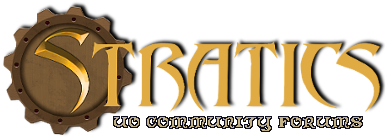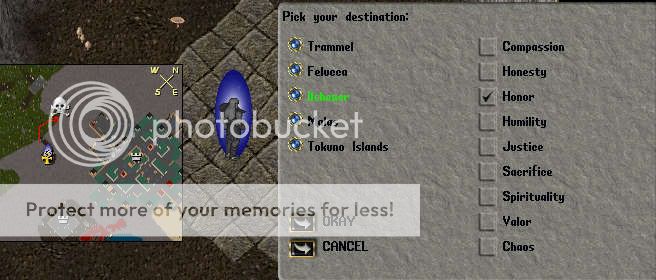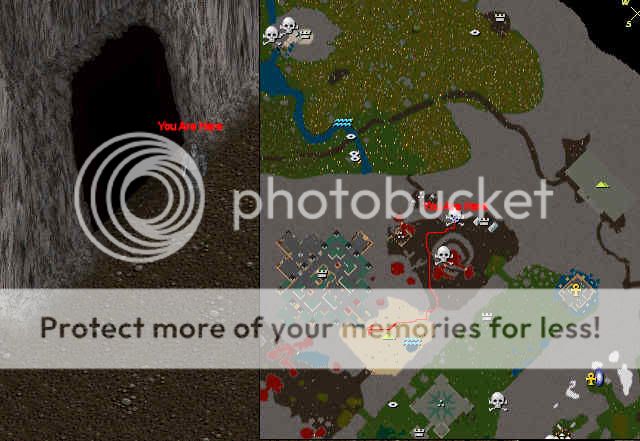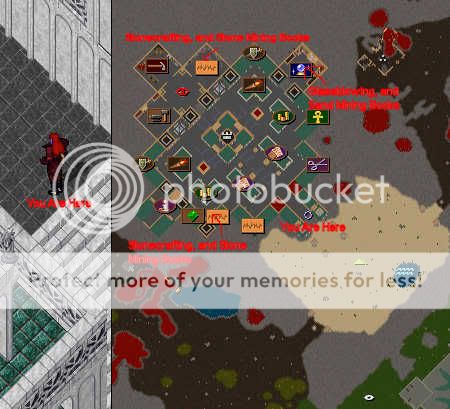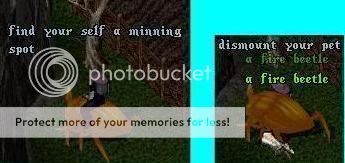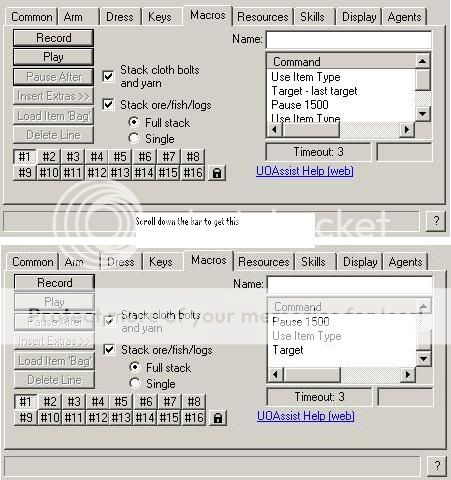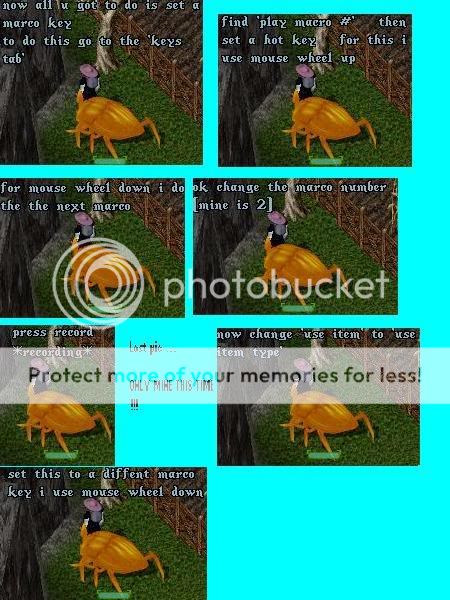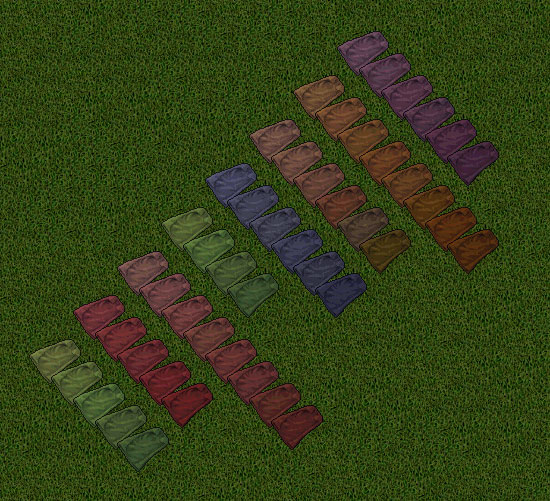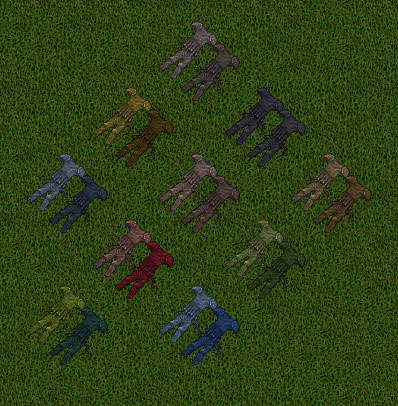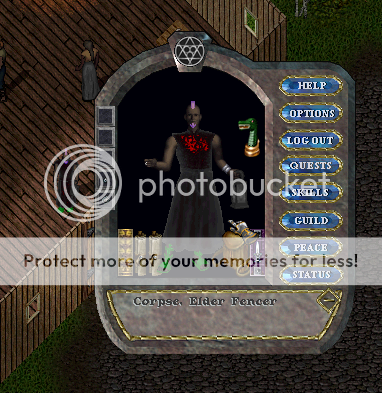Rare Cloth Colours & Mystical Dye Tubs
Rare Cloth Colours & Mystical Dye Tubs
rare, mythical, illegal, old and new
by Feenicks
(updated August 2004 by Boadicea/*; updated again September 2009 by Basara)
Latest update: 22 February 2012.
Pertinent to the Tailoring profession (and to a lesser extent, carpentry) is the availability of a range of cloth colours and other such items that are somewhat less commonly available than the standard range. I hope to detail some of the more commonly asked about items and colours here.
Note that this list is far from complete. Some of the missing colours as well as some of the ones below, can be seen in the following link:
http://www.geocities.jp/uo_color/index.html
1. Ilshenar Green Tub
When Ilshenar first opened there was a dye tub in the house between Sacrifice & Spirituality gates, that has a sheep pen and loom & spinning wheel (where Grandpa Charley now lives - anyone else think that escorting a young girl to go live with an old man in the middle of nowhere, whose only companion is a sheep, is a bit creepy???). This dye tub had a special colour that was very close to ranger green (as available on Ranger Armour or the Leather Dye Tub), and on many shards, a bolt of cloth in that color is still part of the decoration.
Alas the dye tub may be re-coloured by anyone with dyes. Once re-coloured that particular shade of green is irrevocably lost as the tub does not respawn the green colour at server up. I believe that pretty much all shards have had this tub re-coloured making the colour rare unless you dyed numerous bolts of the stuff. The colour can still be gotten off NPC’s clothes (i.e. brigands etc) but is so infrequent it isn't worth the effort.
2. Ranger Green cloth (Updated!)
This was initially not available on a dye tub. This is a perfect match to the colour green found on Ranger Armour (the deepest green on the leather dye tub is supposed to be the same as Ranger Green). This particular shade of cloth was originally only available off NPC tailors selling this cloth. You have to be lucky to find one, they could be anywhere, or not exist at all on your shard (NPC tailors etc in shops sell certain random coloured cloth, some are good shades, some are not, and the colors offered change randomly). The darkest setting of "Forest Green" on the Special Dye Tub appears to be close to this colour, but until someone comes forward with proof, I cannot refute or confirm they are the same colour. A few bugged leather dye tubs are able to dye cloth the leather colors, as well.
In the December 2008-January 2009 "slime dyeing" event, some slimes spawned with a color labeled as "Deep Forest Green". Leather items dyed with this color appear to be actual Ranger Green, and are darker than the darkest "green" setting on the leather dye tub. Comparing the "deep forest green" slime color to the Special Tub color for cloth, seems to be the same for some items, different for others (perhaps because of the darker natural shade of some items). One is limited in means of testing, since so few cloth artifacts exist that can be dyed with the slimes.
Examples:
Robe of the Eclipse, slime dyed: Appears the same (As far as I can tell) as special dye tub colour
Crimson Cincture, slime dyed: appears to be ranger green (aprons are some of the darkest cloth items)
Doublet, dyed with dye tub at darkest forest green setting: visibly several shades lighter than either of the above. Note though, that the Doublet from Melissa (summer 2008 event) looked to be the same color as the CC, until the cloth was cut and reused (example, making a half-apron from Melissa red cloth results in a red that is obviously not a Crimson Cincture). This color difference for Doublets can explain the variation.
Ilshenar Green and Ranger Green colours compared: (picture currently missing)
Ilshenar Green on your left; the richer/darker Ranger Green on your right.
3. Shadow Tub
Rumours cropped up of a dark shadow colour on a dye tub somewhere in Ilshenar similar to the one above. If it ever existed, it was probably kept a closely guarded secret by those who know of it for fear of it being re-coloured like the one above. Its existence has never been confirmed, and by this time, is highly doubtful.
4. Rainbow Cloth
Ahhh the mysterious Rainbow cloth.
Rainbow cloth seems to have been a server up rare.
It is illegal to own and may get you banned. If it doesn’t get you banned it will certainly be deleted on sight by a GM. It seems as if it could have been available on a back room table in the tailor in Ocllo/Haven but possibly only at server up. It came as a folded pile possibly in a quantity of 25. It is also a colour that may have initially caused peoples clients to crash, which may be why it was made illegal. Supposedly that crash bug is now fixed however it remains illegal, possibly for consistency (would be unfair to those who had it deleted if it was made legal and some guy who stored it illegally for years could then come out & make a fortune selling it.
It is black with some speckled colour dots on it:
Special thanks to Uogem for much info on rainbow cloth including the picture - and for spawning one of the longest lived tailor board threads...
5. "Zog" Cloth
Zog cloth is a hoax (probably). Who knows? Best info indicates it may have been obtainable by killing certain NPCs. Most zog cloth that has been referred to is a shade of green although a shade of red has also been mentioned. I wouldn’t bother wasting my time with it, chances are if someone is offering to sell it to you they are scamming you with some odd shade or another and just calling it zog.
The word "zog" was rumored to have come from something that appears in the name of items made of it, but that seems to be a myth. If it was true, it was simply some cloth items some ZOG Cabal roleplayers (and not even the main group of them) had a Seer rename (in which case the items might be of questionable legality), as the "real" ZOG Cabal (aka the Followers of Armegeddon) were 1998-2000 Event NPCs, and as far as can be told, their clothes were just normal clothes (based on screencaps from those events).
The color itself, while rare, spawns randomly on NPC tailors & weavers, and as colors for NPC clothing - and is perfectly legal to own - the only questionable items are ones that may have gotten "ZOG" stuck into the name by someone who had the power to do so in the VERY distant past.
(picture currently missing)
6. Nightmare/Necro/Evil mage/Shadow Cloth
This is a Dark shade of cloth. Perfectly legal. It is very similar to the shade of cloth that Shadowlord faction robes come in. It used to be obtainable by killing NPC evil mages and then cutting up the robes to make fresh clothes out of. Be very wary when forking out a lot of cash to buy it, some items of clothing (pants for instance) dyed with the darkest blue of the special dye tub is easily passed off as necro. Buyer Beware on such items. Most items of this cloth have since been blessed. This colour is also a slightly different shade to BOD Reward "charcoal" colour so beware of such differences as well. Evil mages now have varying shades of blue which are far less appealing and far less valuable, beware of the darker shades of this being passed off as true necro also. Also be wary of folded cloth being passed off as necro, it may not be since stuff often appears darker when folded.
Selayna has provided this further information in regard to nightmare, shadow cloth etc:
Selaynas little "Shadow and Mage cloth Tutorial"
(pictures missing)
From left to right: Shadow Cloth, mage cloth 1, mage cloth 2, mage cloth 3, and on the far right is "nightmare cloth."
Shadow cloth was originally obtained by killing blacksmiths (usually in Buc's Den) and cutting up their aprons. It could also be acquired by cutting up newbie cloaks. Since blacksmiths are invulnerable and you can no longer cut up newbie cloaks, shadow cloth is ( as far as I know) a true rare ( though it is of lower desirability then the other rare shades). Below is a picture of my smith decked out in shadow cloth. Note its silvery grey colour.
Mage cloth 1 is a *VERY* similar shade to mage cloth 2. They don't stack, however, so there is a very small difference. Mage cloth 1 can still be acquired by killing black robed mages in dungeons (Fire, Wisp, Shame, etc.) and cutting up their robes. mage cloth 2 was acquired by killing the black robed mages before OSI Removed mage cloth 2, 3, and nightmare cloth from them.
Mage cloth 3 is a shade that is in-between the dark "nightmare" cloth and the common mage cloth 1. It’s a really pretty shade but I haven't sewn mine into an outfit yet. I believe that the bonnet shown is mage cloth 3, but I can’t' swear to it. To the best of my knowledge it is as rare as the darker cloth, but slightly less desirable. Still, if someone confuses the two it's a fairly minor issue, since they are quite similar.
"Nightmare cloth" is probably the rarest *legal* to own clothing there is, with the possible exception of leprechaun boots. It is a very dark colour ( though lighter then the new charcoal cloth, and better blended IMO ).It matches shadow armour beautifully, as well as nightmares ( hence the name). It does seem to be the same colour as the Shadowlord Faction cloth (which may be why they removed it.)
Below is a picture of my main wearing her "Witch" costume, of Nightmare Cloth dress, cloak, and hat, with leprechaun boots.
Leprechaun boots were acquired on Saint Patrick’s Day in '98 (I believe). OSI spawned leprechauns who had whole suits of leprechaun clothing (which had unique colours but was far less desirable then the boots are) and a green mug of ale (relatively common to this day). While the mugs were saved, most of the boots (which are a unique blue-black that is very dark but not *QUITE* true black were mostly thrown out, and the remaining ones are very rare now.
Lastly, there is something called "Faux Shadow” cloth. It is similar in colour to the mage cloth but less well blended it can be made in a dye tub, and can be useful for making a number of things 'close" to shadow colour
The following diagram shows how to make faux shadow, and shows it compared to mage cloth 1 (the pointer is aimed at the faux shadow):
Enjoy,
Selayna's Player
P.S. There is a similar colour that can be purchased from NPC tailors. It is a bit more blue then any of the above cloths, so it can be told apart that way.
7. Pure White cloth / Thrasher Cloth
Some clothing items such as the surcoat default to a pure white colour when un-dyed but this is not the pure white that is meant by this classification. Nor is it the Ice White color from the BOD system.
Pure White originally came from an unknown source. It would reappear later from an exploit (since fixed) where one could take a "Dread Spider Silk" puff that was the color (but used the wool graphic) from one of the "virtue quests" for minor decorative items (introduced in Publish 38, December 2005), and use it on the spinning wheel (then use the resulting yarn to make cloth on the loom). Another source was from the pure white "Britannia Guard" sashes given out on some shards by Event Mods priot to the dread spider silk. Some people would get multiple sashes, salvage them for 2 cloth each, then make things from the resulting cloth - but this ended up being a VERY minor source of the cloth.
The same exploit also allowed the creation of one of the shadow or nightmare (see above) cloth shades from the "thrasher tail" quest item (which was a recolored flax bundle graphic), but it was much more difficult to get the tail, and the dark color was not as desired as the pure white. As a result, there is a LOT more of this cloth around, even if less of it was actually made than of the white cloth.
While illegal to make, it was considered legal to own, and there is still a lot of the white cloth floating around at high prices for sale. The price on the Thrasher cloth is a lot lower, provided that the buyer knows about the exploit (as it is generally sold as "Evil Mage Cloth").
8. Oilcloth Cloth
For a short time one could use the "combine cloth" feature of the tailor menu to create folded cloth out of oilcloths which shared the oilcloth colour. This colour is a green-yellow colour that is almost identical to a shade of green available on the special dye tub. It is so close as to be indistinguishable and so is barely worth the effort since it isn’t exactly an amazing colour to begin with. You cannot get cloth in this exact colour anymore, but you cannot tell it from the special green unless you compare the two together and even then they are barely distinguishable.
9. Faction Purple
When factions first came out an exploit was discovered that allowed you to permanently "dye" any equippable & wearable item the same purple that a person turns when holding a faction sigil. This resulted in purple deer masks, spellbooks, leather armour, metal armour, lanterns... pretty much anything that anyone could equip was dyed purple somewhere. Such items were highly bannable originally, but became so common (the exploit could happen as a total accident) that EA chose to make such items legal, and to legalize the trick to make items turn that color, in 2004. Eventually, it was discovered that very careful setting of a normal Dye Tub could produce it as well.
Click
here and
here for pictures of the faction purple colour.
10. NPC Cloth
This is simply cloth that comes from either killing NPC’s and cutting up their clothes or from buying cloth from NPC tailors.
Most NPC cloth colours cannot be obtained from any dyetubs. The colours gotton from NPC’s are less inclined to "bleed" like stuff dyed with normal dye tubs. Such colours are sometimes referred to as "Oils". They are usually more sharp and ‘cleaner’ looking than colours done with conventional dye tubs. The much-overdiscussed "Zog" color is one such shade, of many.
11. AOS color "Slime-dyed" cloth & 2008-2009 Slime colors (Updated!)
In 2008, the Oriental shards had an event where magical slimes could be killed, of many different colours, and their corpses could be used (before they decayed) to color cloth. Among the available colours were the shades that had been unique to the 2003 Age of Shadow reward clothes.
Much to the frustration of players of Oceana, European shards & American shards, they did not get such an event (And for those who HATED those colours, were not warned of such a thing occurring), and in addition, extremely overpriced bolts of cloth started appearing from character transfers from those shards (with persons unaware of the event being suckered for extremely overpriced cloth, being told it was rarer than it actually was). This cloth should be considered MORE common than the Pure White cloth, as the only thing limiting the amount of cloth made was the amount of cloth a person could carry (as the Pure White cloth was made with an item from a quest that was limited to one time per character).
In December 2008, all shards were given a new slime event of this type, but the colors were lacking in many ways. One of the BIG problems is that the slimes only dyed artifacts and special-material items (no cloth dying, except for things like the ML Robes, the Crimson Cincture, etc.), so it is unlikely that we will see many minor artifacts dyed then recycled (especially since so many of the robes were turned in for Spring cleaning 2008 points). It is a shame that these colors could not be used on normal cloth, because the colors include Deep Forest (Ranger) Green, a darker blue, and the Champagne "red" (actually a pink color) previously found only on some of the nearly a decade old champagne flutes and bottles.
12. Various BOD reward colours
With the Publish 16 addition of Tailoring BODs a new range of special colour were made available:
Level 1 cloth colors are the first 4 (left to right) of the top row.
Level 2 cloth colors are the red on the top row, and the first three on the second row.
Level 3 cloth colors are the last two of row 2, and the first two of row 3.
Level 4 cloth colors are the last 3 of row 3, and the charcoal shade at the beginning of row 4.
Level 5 colors are the remaining 4 shades on Row 4.
One can only guess that the layout of the colors in this very old picture, was by someone who thought there was only 4 levels of cloth.
13. Stygian Abyss "Abyss Cloth"
This cloth is needed for imbuing certain items, and is dropped by specific ratmen in the Stygian Abyss dungeon. Naturally, it became available with Publish 60, the introduction of the
Stygian Abyss expansion. It is currently unknown if this will continue to be material that one can craft with (cloth coming from quest items having the history that it does), but it is hard to get in sufficient quantities to do anything with (one piece at a time).
It took Corpse over 10 hours to obtain the 18 pieces of cloth needed for this doublet and skirt.
14. Wedding Cloth
The
High Seas expansion introduced a revamp of MIB/SOS loot, including rare items possible in the chests. One of the items was "An Antique Wedding Dress", that can be recycled for cloth. The colour of the dress (and cloth) is a bit hard to describe, having at least two sub-shades. The best way I can describe it is a cream colour, with peach and blue undertones that show up in certain places. While the dresses drop about every 5 or so SOS chests, it takes two dresses' worth to make most items. It often sells for 100k to 1 million gold per item made of it/stack of 10-15 cloth.
15. A note on sandals
There are a range of Sandals that are of differing colours.
* Pure black were most commonly sought after before the introduction of Tailor BODs. They are legal to own but you can no longer acquire them.
* Silver colours usually come from killing NPC brides and are legal.
* Blues usually come from evil mages and are of course legal.
* With the AoS gift people could chose sandals as a reward and select the option to dye them themselves – so colours can now be seen in all the colours of the dye tub, plus there were several unique colors (at least until 2008).
There are a range of other colours and variations available from a range of NPCs with some people fostering collections. I'll leave it to you to find out where to get them all...
With the Publish 16 Tailoring BODs a range of coloured sandals as reward was made available. These Sandals have a 10% chance of dropping from a small tailor BOD that would produce level 4 reward cloth, or a 20% chance from a small tailor BOD that would drop level 5 reward cloth. They, in fact, come in the COLOURS of those levels of reward cloth, but it is possible to get a level 5 coloured pair of sandals from a level 4 color BOD, and vice versa.
(picture missing)
